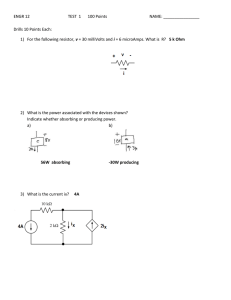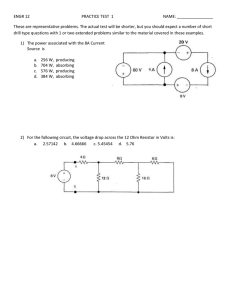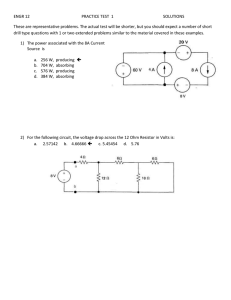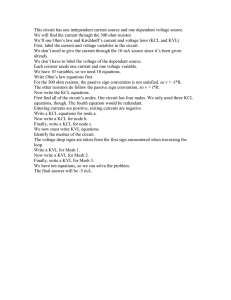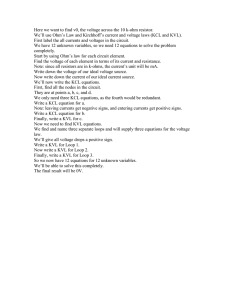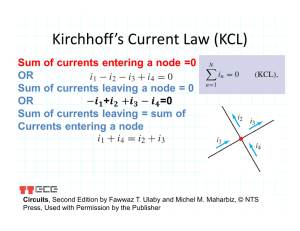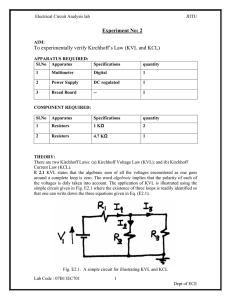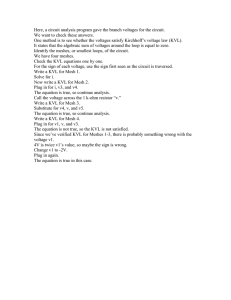EE2301 Advanced Tutorial Problems Kirchhoff`s Current Law
advertisement
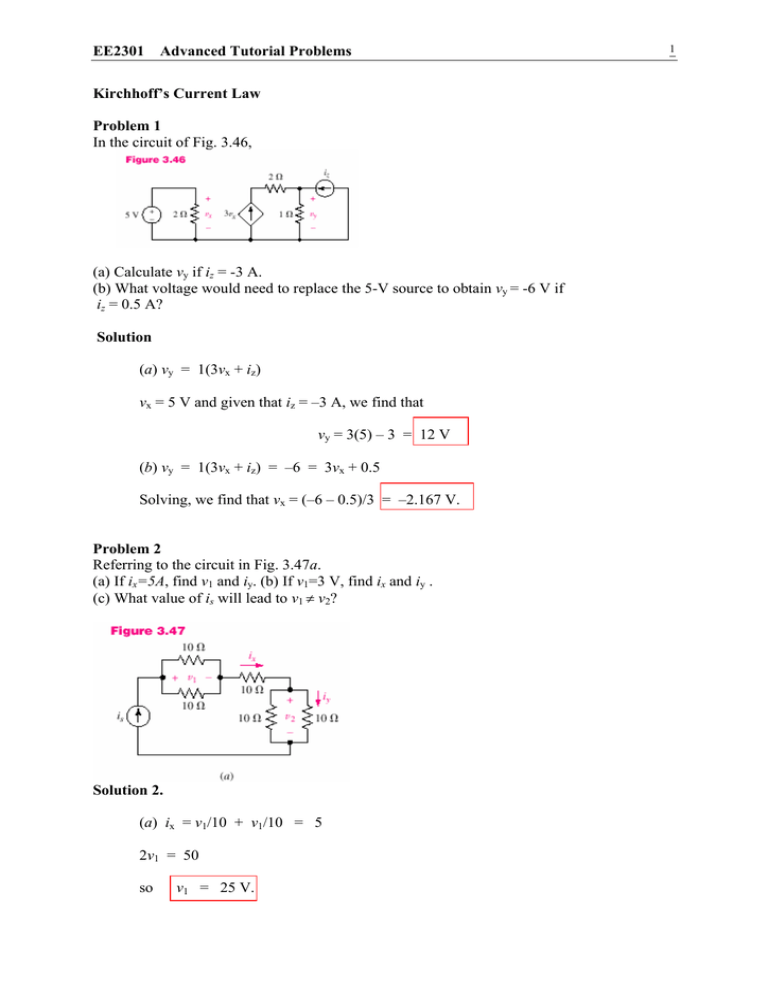
EE2301 Advanced Tutorial Problems Kirchhoff’s Current Law Problem 1 In the circuit of Fig. 3.46, (a) Calculate vy if iz = -3 A. (b) What voltage would need to replace the 5-V source to obtain vy = -6 V if iz = 0.5 A? Solution (a) vy = 1(3vx + iz) vx = 5 V and given that iz = –3 A, we find that vy = 3(5) – 3 = 12 V (b) vy = 1(3vx + iz) = –6 = 3vx + 0.5 Solving, we find that vx = (–6 – 0.5)/3 = –2.167 V. Problem 2 Referring to the circuit in Fig. 3.47a. (a) If ix=5A, find v1 and iy. (b) If v1=3 V, find ix and iy . (c) What value of is will lead to v1 ≠ v2? Solution 2. (a) ix = v1/10 + v1/10 = 5 2v1 = 50 so v1 = 25 V. 1 EE2301 Advanced Tutorial Problems 2 By Ohm’s law, we see that iy = v2/10 also, using Ohm’s law in combination with KCL, we may write ix = v2/10 + v2/10 = iy + iy = 5 A Thus, iy = 2.5 A. (b) From part (a), ix = 2 v1/ 10. Substituting the new value for v1, we find that ix = 6/10 = 600 mA. Since we have found that iy = 0.5 ix, iy = 300 mA. (c) no value – this is impossible. Problem 3. Find R and G in the circuit of Fig. 3.47b if the 5-A source is supplying 100 W and the 40-V source is supplying 500 W. Figure 3.47 Solution. We begin by making use of the information given regarding the power generated by the 5-A and the 40-V sources. The 5-A source supplies 100 W, so it must therefore have a terminal voltage of 20 V. The 40-V source supplies 500 W, so it must therefore provide a current of 12.5 A. These quantities are marked on our schematic below: (1) By KVL, -40 – 110 + R(5) = 0 EE2301 Advanced Tutorial Problems 3 Thus, R = 30 W. (2) By KVL, -VG – (-110) + 40 = 0 So VG = 150 V Now that we know the voltage across the unknown conductance G, we need only to find the current flowing through it to find its value by making use of Ohm’s law. KCL provides us with the means to find this current: The current flowing into the “+” terminal of the –110-V source is 12.5 + 6 = 18.5 A. Then, Ix = 18.5 – 5 = 13.5 A By Ohm’s law, I x = G · VG So G = 13.5/ 150 or G = 90 mS Kirchhoff’s Voltage Law Problem 4. In the circuits of Fig. 3.48a and b, determine the current labeled i. Solution (a) -1 + 2 + 10i – 3.5 + 10i = 0 Solving, i = 125 mA (b) +10 + 1i - 2 + 2i + 2 – 6 + i = 0 Solving, we find that 4i = -4 or i = - 1 A. EE2301 Advanced Tutorial Problems Problem 5. Use Ohm’s and Kirchhoff’s laws on the circuit of Fig. 3.49 to find (a) vx ;(b) iin;(c) Is ;(d) the power provided by the dependent source. Solution (a) By KVL, -2 + vx + 8 = 0 so that vx = -6 V. (b) By KCL at the top right node, IS + 4 vx = 4 - vx/4 So IS = 29.5 A. (c) By KCL at the top left node, iin = 1 + IS + vx/4 – 6 or iin = 23 A (d) The power provided by the dependent source is 8(4vx) = -192 W. 4 5 EE2301 Advanced Tutorial Problems Problem 6 (a) Use Kirchhoff’s and Ohm’s laws in a step-by-step procedure to evaluate all the currents and voltages in the circuit of Fig. 3.50. (b) Calculate the power absorbed by each of the five circuit elements and show that the sum is zero. Solution (a) Working from left to right, v1 = 60 V v2 = 60 V i2 = 60/20 = 3 A i4 = v1/4 = 60/4 = 15 A v3 = 5i2 = 15 V By KVL, -60 + v3 + v5 = 0 v5 = 60 – 15 = 45 V v4 = v5 = 45 v1 = 60 V v2 = 60 V v3 = 15 V v4 = 45 V v5 = 45 V i1 = 27 A i2 = 3 A i3 = 24 A i4 = 15 A i5 = 9 A i5 = v5/5 = 45/5 = 9 A i3 = i4 + i5 = 15 + 9 = 24 A i1 = i2 + i3 = 3 + 24 = 27 (b) It is now a simple matter to compute the power absorbed by each element: p1 p2 p3 p4 p5 = -v1i1 = v2 i 2 = v3 i 3 = v4 i 4 = v5 i 5 = -(60)(27) = (60)(3) = (15)(24) = (45)(15) = (45)(9) = -1.62 kW = 180 W = 360 W = 675 W = 405 W and it is a simple matter to check that these values indeed sum to zero as they should. EE2301 Advanced Tutorial Problems Problem 7 Refer to the transistor circuit shown in Fig. 3.52. Keep in mind that although we do not know the current-voltage relationship for the device, it still obeys both KCL and KVL. (a) If ID = 1.5 mA, compute VDS. (b) If ID = 2 mA and VG = 3 V, compute VGS. Solution (a) By KVL, -12 + 5000ID + VDS + 2000ID = 0 Therefore, VDS = 12 – 7(1.5) = 1.5 V. (b) By KVL, - VG + VGS + 2000ID = 0 Therefore, VGS = VG – 2(2) = -1 V. Singe Loop Circuit Problem 8. Find i1 in the circuit of Fig. 3.54 if the dependent voltage source is labeled: (a) 2v2; (b) 1.53v3 ; (c) –15i1. 6 7 EE2301 Advanced Tutorial Problems Solution (a) We first apply KVL: -20 + 10i1 + 90 + 40i1 + 2v2 = 0 where v2 = 10i1. Substituting, 70 + 70 i1 = 0 or i1= -1 A. (b) Applying KVL, -20 + 10i1 + 90 + 40i1 + 1.5v3 = 0 [1] where v3 = -90 – 10i1 + 20 = -70 – 10 i1 alternatively, we could write v3 = 40i1 + 1.5v3 = -80i1 Using either expression in Eq. [1], we find i1 = 1 A. (c) Applying KVL, -20 + 10i1 + 90 + 40i1 - 15 i1 = 0 Solving, i1 = - 2A. Problem 9. Refer to the circuit of Fig. 3.54 and label the dependent source 1.8v3. Find v3 if (a) the 90-V source generates 180 W; (b) the 90-V source absorbs 180 W; (c) the dependent source generates 100 W; (d) the dependent source absorbs 100 W of power. Solution Applying KVL, we find that -20 + 10i1 + 90 + 40i1 + 1.8v3 = 0 Also, KVL allows us to write v3 = 40i1 + 1.8v3 v3 = -50i1 So that we may write Eq. [1] as 50i1 – 1.8(50)i1 = -70 [1] EE2301 Advanced Tutorial Problems 8 or i1 = -70/-40 = 1.75 A. Since v3 = -50i1 = -87.5 V, no further information is required to determine its value. The 90-V source is absorbing (90)(i1) = 157.5 W of power and the dependent source is absorbing (1.8v3)(i1) = -275.6 W of power. Therefore, none of the conditions specified in (a) to (d) can be met by this circuit. Problem 10. In Fig. 3.59, if gm = 25 ×10-3 siemens and vs = 10 cos 5t mV, find vo(t). Solution We can apply Ohm’s law to find an expression for vo: vo = 1000(–gm vp) We do not have a value for vp, but KVL will allow us to express that in terms of vo, which we do know: –10×10–3 cos 5t + (300 + 50×103) i = 0 where i is defined as flowing clockwise. Thus, vp = 50×103 i = 50×103 (10×10–3 cos 5t) / (300 + 50×103) = 9.940×10–3 cos 5t V and we by substitution we find that vo = 1000(–25×10–3)( 9.940×10–3 cos 5t ) = –248.5 cos 5t mV 9 EE2301 Advanced Tutorial Problems Series and Parallel Connected Independent Source Problem 11 Using series combinations of sources, compute i for both circuits in Fig. 3.71. Solution (a) Applying KCL, 1 – i – 3 + 3 = 0 so i = 1 A. (b) The rightmost source should be labeled 3.5 A to satisfy KCL. Then, looking at the left part of the circuit, we see 1 + 3 = 4 A flowing into the unknown current source, which, by virtue of KCL, must therefore be a 4-A current source. Thus, KCL at the node labeled with the “+” reference of the voltage v gives 4–2+7–i = 0 or i = 9A Resistors in Series and Parallel Problem 12. In the network shown in Fig. 3.83: (a) let R = 80 Ω and find Req; (b) find R if Req = 80 Ω; (c) find R if R =Req. Solution (a) Req = [(40 W + 20 W) || 30 W + 80 W] || 100 W + 10 W = (b) Req = 80 W = [(40 W + 20 W) || 30 W + R] || 100 W + 10 W 70 W = [(60 W || 30 W) + R] || 100 W 1/70 = 1/(20 + R) + 0.01 20+ R = 233.3 W therefore R = 213.3 W. (c) R = [(40 W + 20 W) || 30 W + R] || 100 W + 10 W 60 W. 10 EE2301 Advanced Tutorial Problems R – 10 W = [20 + R] || 100 1/(R – 10) = 1/(R + 20) + 1/ 100 3000 = R2 + 10R – 200 Solving, we find R = -61.79 W or R = 51.79 W. Clearly, the first is not a physical solution, so R = 51.79 W. Problem 13. For the circuit in Fig. 3.91, determine ix, and compute the power dissipated by (absorbed by) the 15-kΩ resistor. Solution Replace the top 10 kW, 4 kW and 47 kW resistors with 10 kW + 4 kW || 47 kW = 13.69 kW. Define vx across the 10 kW resistor with its “+” reference at the top node: then vx = 5 · (10 kW || 13.69 kW) / (15 kW + 10 || 13.69 kW) = 1.391 V ix = vx/ 10 mA = 139.1 mA v15 = 5 – 1.391 = 3.609 V and p15 = (v15)2/ 15×103 = 868.3 mW.
